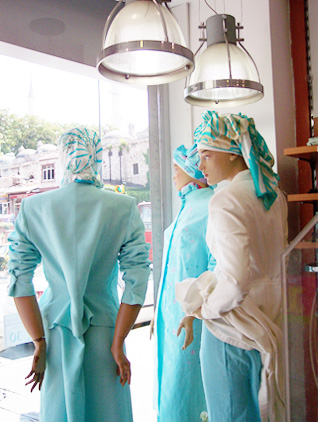
In the news
“Allah’s Tailors” gaining profile in Turkey [Reuters]
City’s Muslim women go for fancy burkhas this Ramzan [DN&A]
Prepping for a Chic Idul Fitri” [Jakarta Globe]
Unveiling the Haute Hijab [Illume]
Jakarta's Change to Lead Fashion for Faithful [Financial Times]
What the Headscarf Means, When Everyone Wears One [NY Times]
Turning East, Turkey Asserts Economic Power [NY Times]
PBS: “Essay: Bordering on What? [PBS]
What is veiling fashion?
In this project Gökarıksel and Secor use ‘veiling-fashion’ to describe what is often called tesettür-fashion in Turkish. Tesettür is derived from the Arabic root s-t-r, which means covering or a curtain. It is used in Turkish to signify a set of Islamic practices wherein women cover their heads and bodies and usually avoid contact with unrelated men. But tesettür has proven to be a slippery signifier in Turkish society, especially following the emergence of a new apparel sector that uses this term to market its products. While in the 1980s and early 1990s, these commodities were limited to oversized headscarves, long overcoats, and modest dress, over time the growth of the industry, its insertion into global fashion networks, and the demand for innovation have led to the wide diversification of veiling-fashion. Today’s veiling-fashion producers market colorful and constantly changing styles, from bold and close-fitting to more conservative ones. Whether and to what extent these styles and their marketing are ‘Islamic’ is a topic of ongoing debate. Read more →
new publication
Veiling-fashion, with its array of brands and ever-changing styles, has been on the rise in Turkey in the past decade. Although the producers of these styles present them as the perfect melding of fashion and piety, our analysis of focus groups with consumers in Istanbul and Konya in 2009 shows that veiling-fashion is, in practice, rife with ambivalence. Veiling is undertaken in relation to the moral code of of Islam, but fashion, as consumption, works as part of an ever-shifting economy of taste and distinction. In Baudrillard's terms, veiling-fashion is morally ambivalent, caught between its function as modest covering according to Islam and its social signification. In their negotiation of this ambivalence, consumers of these styles turn veiling-fashion into an ethical practice, into part of how they form themselves in relation both to a moral code (Islam) and to the aesthetics, politics, and pleasures of their sociospatial environments. The ethical practice of veiling-fashion thus engages a complex spatial field of bodies, homes, streets, military or state spaces, and public arenas. Veiling-fashion consumers describe their daily practices in terms of a problem of self-governance, or the management of nefis, the bodily or material desires aroused by consumption and its display. In this management of nefis through the technology of veiling-fashion these women form themselves as subjects of ethico-politics in Turkey today.
Read "‘Even I Was Tempted:’ The Moral Ambivalence and Ethical Practice of Veiling-Fashion in Turkey," →
